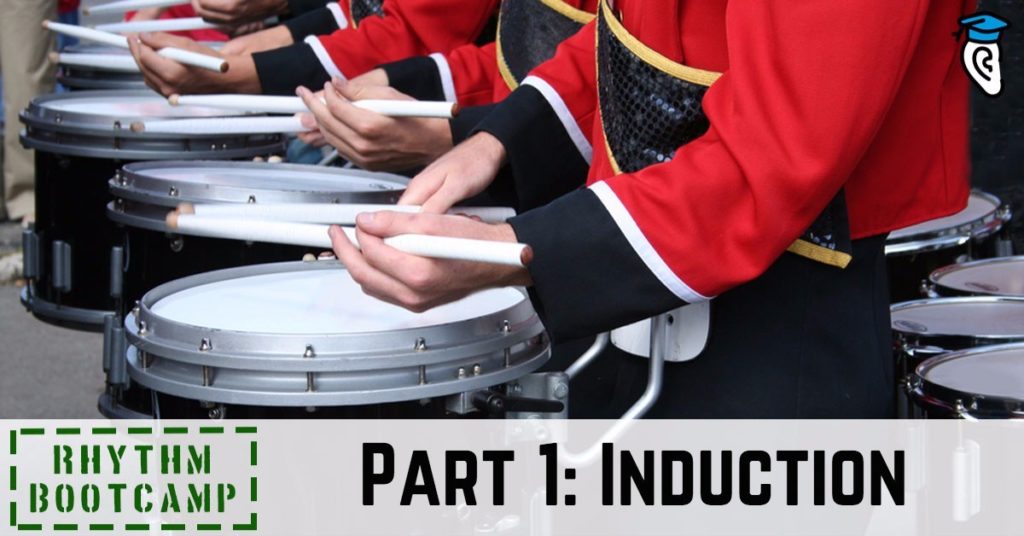
For those musicians who were born with drumsticks in their hands, playing and tapping on everything in sight, rhythm comes as natural as breathing. They gather with others of their kind, explaining rhythms in bizarre drum talk that only a percussionist could understand. For the rest of us, developing tight rhythm takes time and practice. Those people need: Rhythm Bootcamp!
Who is this series for?
- Rhythm Bootcamp is for the band member who worries they have no rhythm.
- Rhythm Bootcamp is for the beginner drummer whose inner clock is more like a tripping camel than a steady heartbeat.
- Rhythm Bootcamp is for every musician who has ever rushed a solo, lost time, or dragged the beat of a song way back into last year…
In a nutshell, Rhythm Bootcamp is for every musician! What will we be covering in this series? Read on to find out.
Note: If you are totally new to learning rhythm you might like to start with the Get Rhythm series first. Rhythm Bootcamp is for honing and improving your sense of rhythm and we’ll assume you have a good grasp of the fundamental concepts already.
How to Train Your Sense of Rhythm
This series will provide you with professional insight on mastering rhythm. Like any musical skill, developing rhythm involves a broader variety of aspects than you might first expect. In this series you will:
- Practice problem areas like transitions, solos, and improvisation, where most musicians struggle to keep the beat.
- Use exercises and downloadable practice tracks for solid ear training practice.
- Learn how to use techniques like visualization to boost your rhythmic power.
- Discover practical tips from the pros.
- And most of all, have fun learning rhythms with familiar tunes and musical styles.
The Importance of Everyday Ear Training
Mastering rhythm involves practice – everyday practice. Like teaching your hands how to play a chord or where the piano keys are without looking, internalizing rhythm until it is second nature involves both mental and physical training. You can start simple, like tapping your toe to the radio, or clapping along. Some forms of music like country music and dance have clear-cut beats, usually in 4/4, that are easy to follow.
Let’s get started with a couple of simple, fun exercises you can use to start connecting with your inner sense of the rhythm.
Exercise 1: Clapping to Country
In this simple exercise, practice finding the beat in this fun-loving country tune “Shut up and fish” by Maddie & Tae.
Maddie & Tae “Shut Up and Fish”
Instructions
- Listen to the first minute of “Shut Up and Fish”
- Tap your toe to the beat.
- Try clapping along on beats 2 and 4, with the snare beat.
Exercise 2: Tapping on Ice
For a retro dance throwback, try bopping your head along with “Ice Ice Baby”, the song we all wish we could forget. Let your body internalize the beat. Believe it or not, there’s a reason why drummers keep their bodies bopping to the rhythm whenever they hear a beat they like. They have internalized rhythm, so grow your inner beat by jamming out to this throwback from the 90s.
Vanilla Ice “Ice Ice Baby”
Instructions
- Listen to the first minute of “Ice Ice Baby”
- Tap your toe to the beat.
- Start clapping on beats 2 and 4.
- And just for kicks, try bopping your head in time to the beat.
- If you are really brave, or just hiding out in your room, let your whole body feel the beat and let loose. Yep, that’s what internalizing rhythm is all about!
As you practice different exercises in this series, pay attention to how you handle transitions, where you have a tendency to rush or drag the tempo, and how your body physically reacts. This includes involuntarily tapping your foot to a catchy tune or maybe unconsciously subdividing a beat under your breath.
Even if you cannot read a note of music or think you lack any semblance of good rhythm, you can master rhythm with practice!
How to Use this Series
Be sure to read through each article in this series. These exercises are designed for beginning and intermediate musicians alike, for both those that learn by ear and those that read music. Every musician will learn a valuable skill by practicing these simple exercises. Educators might find these exercises helpful for students who have difficulty with rhythm, and seasoned pros might have fun testing out their rhythmic prowess and discover a new exercise to incorporate into their daily practice.
You will get the most out of these exercises if you:
- Download all of the exercises and examples.
- Practice them every day.
- Listen to exercises and rhythms passively and actively.
When you listen to audio passively, like playing it in the background while you drive, work, or cook at home, you are allowing your mind to absorb the music. When you actively listen, you have your undivided attention on the audio and are counting or playing along with the exercise. Musicians will find that both passive and active listening are helpful in learning to master a new skill like rhythm.
What you want to do is internalize rhythm, internalize the pulse. Eventually, rhythm will become second nature to you. Every musician starts somewhere, and your journey to awesome rhythm begins now! Click here to learn what to do if you “Got no rhythm”.







